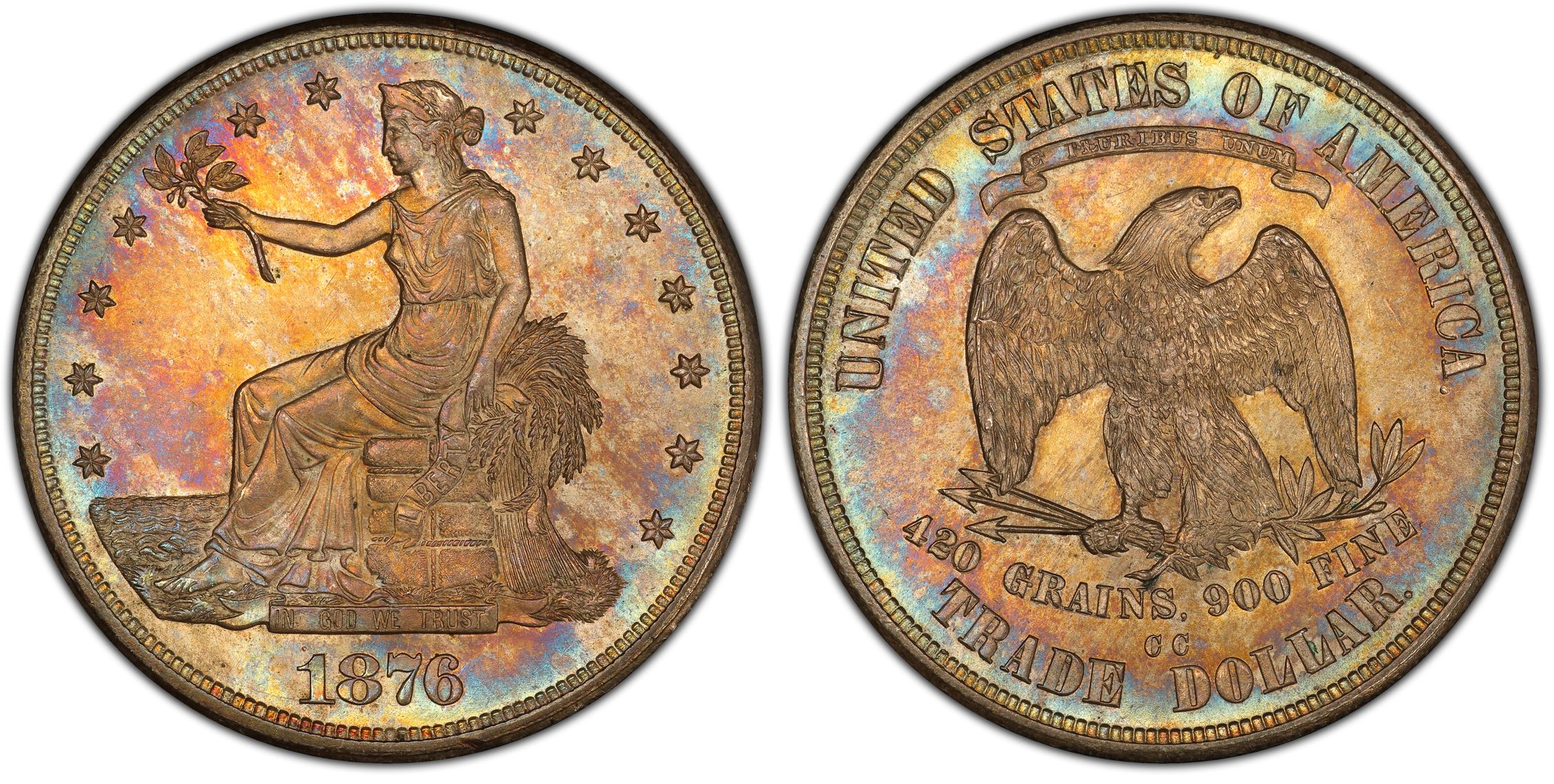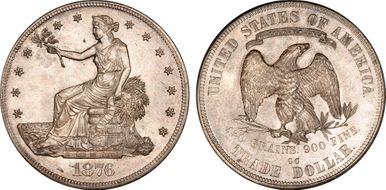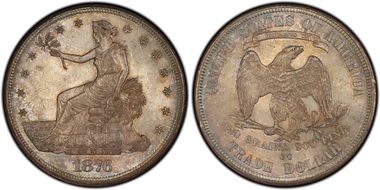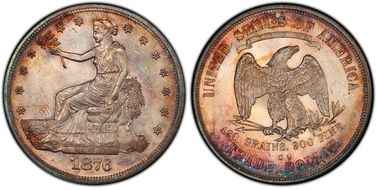- PCGS #:
- 7042
- Designer:
- William Barber
- Edge:
- Reeded
- Diameter:
- 38.10 millimeters
- Weight:
- 27.20 grams
- Mintage:
- 509,000
- Mint:
- Carson City
- Metal:
- 90% Silver, 10% Copper
- Auction Record:
- $63,800 • MS66 • 04-01-1997 • Bowers & Merena
Die Varieties
- 1876-CC T$1 C-2 Small Wide CC, Chopmarked
- 1876-CC T$1 Type-I/II Chopmarked
- 1876-CC T$1 FS-801, C-1.1 DDR Chopmarked
- 1876-CC T$1 Type-I/II
- 1876-CC T$1 Type-I/II, PL
- 1876-CC T$1 FS-801 DDR
- 1876-CC T$1 FS-801, C-1 DDR
- 1876-CC T$1 FS-801, C-1.1 DDR Connected CC
- 1876-CC T$1 C-3.2 Pitted Stars
- 1876-CC T$1 C-5.2
- 1876-CC T$1 C-2 Small Wide CC
Go To Grade
Current Auctions - PCGS Graded
Current Auctions - NGC Graded
For Sale Now at Collectors Corner - PCGS Graded
For Sale Now at Collectors Corner - NGC Graded
Rarity and Survival Estimates Learn More
| Survival Estimate | |
|---|---|
| All Grades | 300 |
| 60 or Better | 40 |
| 65 or Better | 1 |
| Numismatic Rarity | |
|---|---|
| All Grades | R-6.4 |
| 60 or Better | R-8.7 |
| 65 or Better | R-10.0 |
| Relative Rarity By Type All Specs in this Type | |
|---|---|
| All Grades | 1 / 18 TIE |
| 60 or Better | 1 / 18 |
| 65 or Better | 1 / 18 TIE |
| Relative Rarity By Series All Specs in this Series | |
|---|---|
| All Grades | 1 / 18 TIE |
| 60 or Better | 1 / 18 |
| 65 or Better | 1 / 18 TIE |
Condition Census What Is This?
Q. David Bowers:
The following narrative, with minor editing, is from my "Silver Dollars & Trade Dollars of the United States: A Complete Encyclopedia" (Wolfeboro, NH: Bowers and Merena Galleries, Inc., 1993).
Coinage Context
Production halted early in year: The Carson City Mint started the year 1876 with 216,000 pieces struck in January, a generous figure. However, the amount declined to 80,000 in February, rose slightly to 85,000 in March, and continued to 128,000 in April, totaling 509;000 at which point coinage ceased for the year.
Numismatic Information
Circulated grades: In circulated grades from VF-20 to AU-58 the 1876-CC is somewhat scarce, though not rare. An estimated 1,500 to 2,500 coins exist, enough that anyone seeking a specimen can locate a satisfactory piece in relatively short order. A survey of eight coins (admittedly, a small sample) conducted by Mark Borckardt in 1992 found one of the I/I type and seven of the I/II.
Chopmarked pieces are somewhat scarce, with the Type I/II being the issue usually encountered.
Mint State grades: At the MS-65 level the 1876-CC may be unknown. In any Mint State grade it is a rarity. I estimate that just 2 to 4 MS-64 coins, only 5 to eight MS-63 pieces, and only 20 to 40 MS-60 to 62 specimens survive. These estimates are based upon conversations with specialists, printed population reports of certification services, and my own observations. As the rarity of the 1876-CC in Mint State is not widely known, certain professional numismatists and others have felt that it is not hard to find. For this reason, the population estimates I give in this book may err in being too liberal. Mint State coins may be even rarer than I say!
Considering all Mint State grades combined, the 1876-CC is the rarest of all trade dollars, and even outranks the famous 1878-CC. Any Mint State example of the 1876-CC is a rare prize. It is worth noting that the three coins in John M. Willem's personal reference collection were EF, EF, and AU.
In his 1980 study! Maurice Rosen stated that in years of looking he had seen only two 1876-CC trade dollars which he could truly describe as being in Mint State. Most pieces described as "Uncirculated" in dealers' offerings weren't. He noted that in a 1977 auction a "Brilliant Uncirculated" piece, so described, was graded by him as only EF-45, heavily bagmarked, and with scratches!
Bruce Amspacher reported this:" "I have asked many veteran dealers about this date, and almost without exception they state that they have 'never seen a nice one."
Varieties: The 1876-CC exists in types I/I and I/II, with Type I/I believed to be the scarcest.
Doubled reverse die: Of all of the various die repunching, doublings, etc., in the trade dollar series, the 1876-CC I/I with doubled reverse die takes the cake as a mint gaffe. However, the 1876-5 II/II with doubled obverse die gives it a close run for the money.
Of the 1876-CC error, Bill Fivaz writes (letter to the author, November 30, 1991; another, January 29, 1992, contained additional data.):
This is probably the strongest and most widely spaced doubled die known in any series. The reverse die shows dramatic doubling on the eagle's left wing (on the right side of the coin), the branches, berries, leaves, and much of the lettering. While not exceedingly rare, once you've found one, this scarce variety is very marketable due to the strength of the doubling. (This is not the doubled reverse die of 1875-CC.)
Known examples include the following:
1.Jack Beymer, discovery coin; VF-30. described by Dr. John W. McCloskey and illustrated in The Gobrecht Joumal; November 1984
2. Jeff Oxman.
3. Lloyd White.
4. Bill Fivaz, EF.
5. Bill Fivaz, AU; described in Coin World May 24, 1989, p.74.
6. Jack White, AU, with five chopmarks,
7. New England Collection, EF, chopmarked,
8. Leroy C. Van Allen Collection; sold into a New England collection 6/92, AU.
9. Bert A. Schlosser, EF cleaned, received on 6/4/92 from a Coin World, advertiser who listed it as a regular (not doubled die) coin.
10. Larry Comer Collection, EF-40.
11. Several others have been reported.
Some of the preceding listings may represent duplications. To date, all specimens reported to me have been in circulated grades.
Varieties:
OBVERSE TYPE I: RIBBON ENDS POINT LEFT, 1873-1876
REVERSE TYPE I: BERRY BELOW CLAW, 1873-1876
Circulation strikes:
1. Micro cc (a.k.a, Wide cc): Breen-5804. Mintmark .74 mm high; 1.2 mm spacing between C's. Quite scarce, An MS-63 coin is in the Dr. James A. Stiles Collection.
2. Medium CC: Mintmark 1.1 mm high; .5 mm spacing between C's.
3. Tall CC: Breen-5805. Scarce. Minor varieties, apparently from leftover 1875-CC dies (Breen- 5796).
Note: One Mint State 1876-CC I/I trade dollar seen by the author, mintmark size not recorded, had a large patch of unfinished die area surrounding the eagle's sinister wing tip.
4. Tall CC. Doubled reverse die:(See: McCloskey, John W. "A Doubled Die 1876-CC Trade Dollar." The Gobrecht Joumal, November 1984.) Breen-5805A. Fivaz & Stanton $1014. Presently extremely rare. Spectacularly doubled in areas, a feature most no-ticeable on the olive branch (especially above IN of FINE) and on the motto E PLURIBUS UNUM. The VF-30 discovery coin was shown at the 1984 ANA Convention by Jack Beymer. Each C in the mintmark measures 1.2 mm high by 0.8 mm wide.
OBVERSE TYPE I: RIBBON ENDS POINT LEFT, 1873-1876
REVERSE TYPE II: NO BERRY BELOW CLAW, 1875-1885
Circulation strikes:
1. Medium CC: Mintmark 1.1 mm high; .7 mm spacing between C's.
2. Tall CC: Breen-5806. Mintmark 1.17 mm high; .5 mm spacing between C's. Minor varieties. Very common, but usually seen in low grades. Very few seen Uncirculated. Compare Norweb:1531.
More chop marked coins survive of Type I/II than of Type I/I.
Dies prepared: Obverse: 24; Reverse: 2 (Obviously, the Carson City Mint had on hand a number of serviceable reverse dies (types I and II) from 1874-1875.)
Circulation strike mintage: 509,000. Delivery figures by month: January: 216,000; February: 80,000;
March: 85,000; April: 128,000; May-December: none.
Characteristics of striking: Usually well struck. A few have prooflike surfaces.
Known hoards of Mint State coins: In the 1970s World-Wide Coin Investments distributed a group of about 15 pieces.
Rarity with original Chinese chopmark(s): Type I/I. Very scarce; Type I/II. Somewhat scarce.
Commentary
The 1876-CC is somewhat scarce in all grades and in Mint State is the rarest of all circulation strike trade dollars.
Additional Information
The Local Scene in Nevada
Following the Act of July 22, 1876, which eliminated the legal tender status of trade dollars, they began selling at a discount almost immediately. The August 3, 1876 issue of the Territorial Enterprise, Virginia City, Nevada, told of the situation (citation from Willem, The United States Trade Dollar): This newspaper is perhaps best known to historians today because of Samuel L. Clemens' employment there.)
"A meeting of the retail dealers of Virginia was held last night in the rooms over the Delta Saloon. For some reason there was a small attendance, only 24 saloons being represented-or about one-seventh of the business. There was a great deal of buzzing going on before the meeting commenced, and the proper course to adopt was eagerly discussed.
"Mr. Adams stated that the object of the meeting was to get the voice of the saloon-keepers as to what course should be adopted with regard to trade dollars. He was in favor of discontinuing their acceptance altogether after the second day of next month .... Mr. Orndorff states that it was intended as a general meeting, and he desired to hear from all the whiskey men present. Mr. Vucovitch advocated the plan of refusing trade dollars altogether, and thought immediate action necessary. Mr. Oliver favored the 90 cents proposition and immediate action.
"Mr. Riorden gave an instance where a good customer one who would be liable at any time to throw down a five dollar gold piece if he wanted to drink-would get the worst of it. The liberal man puts out a piece of gold and takes his change in silver, while the mean man sells his gold for trade dollars and takes one of them to buy a drink. Under the present system he would get back a half, quarter, and a dime, and it would be cheaper to give the man his drink than to give him the change. A speaker said that he was in favor of discounting trades so much there could be nothing made by buying them with gold and paying them out.
"Mr. Sliter of '66' was called upon, but as he was the only representative of the two-bit houses (Most saloons charged 15¢ for a drink; "two-bit houses" charged 25¢.) present he declined to commit himself, saying only that he was in favor of the movement if the rest would stand in J.P. Penhal, commonly known as Captain Jack, thought trade dollars ought to be received for bills contracted during the past month, and Mr. Oliver said he was willing to take them for all that was owing him. On a motion by Mr. Orndorff, a resolution was adopted specifying that trade dollars should only be taken at 87-1/2.
"It was ordered by the meeting that the chair appoint a committee of four to obtain signatures to an agreement, The chair appointed a committee and instructed it to report at the same place of meeting this evening at half-past seven o'clock. After the agreement had been signed by the majority of those present, the" meeting was declared adjourned. Considering the fact that it was a crowd of liquor dealers, the meeting was a very dry one. Not one of them offered to 'ring the bell (Treat the assembled guests to a round of drinks.) during the entire evening."
Coinage Context
Production halted early in year: The Carson City Mint started the year 1876 with 216,000 pieces struck in January, a generous figure. However, the amount declined to 80,000 in February, rose slightly to 85,000 in March, and continued to 128,000 in April, totaling 509;000 at which point coinage ceased for the year.
Numismatic Information
Circulated grades: In circulated grades from VF-20 to AU-58 the 1876-CC is somewhat scarce, though not rare. An estimated 1,500 to 2,500 coins exist, enough that anyone seeking a specimen can locate a satisfactory piece in relatively short order. A survey of eight coins (admittedly, a small sample) conducted by Mark Borckardt in 1992 found one of the I/I type and seven of the I/II.
Chopmarked pieces are somewhat scarce, with the Type I/II being the issue usually encountered.
Mint State grades: At the MS-65 level the 1876-CC may be unknown. In any Mint State grade it is a rarity. I estimate that just 2 to 4 MS-64 coins, only 5 to eight MS-63 pieces, and only 20 to 40 MS-60 to 62 specimens survive. These estimates are based upon conversations with specialists, printed population reports of certification services, and my own observations. As the rarity of the 1876-CC in Mint State is not widely known, certain professional numismatists and others have felt that it is not hard to find. For this reason, the population estimates I give in this book may err in being too liberal. Mint State coins may be even rarer than I say!
Considering all Mint State grades combined, the 1876-CC is the rarest of all trade dollars, and even outranks the famous 1878-CC. Any Mint State example of the 1876-CC is a rare prize. It is worth noting that the three coins in John M. Willem's personal reference collection were EF, EF, and AU.
In his 1980 study! Maurice Rosen stated that in years of looking he had seen only two 1876-CC trade dollars which he could truly describe as being in Mint State. Most pieces described as "Uncirculated" in dealers' offerings weren't. He noted that in a 1977 auction a "Brilliant Uncirculated" piece, so described, was graded by him as only EF-45, heavily bagmarked, and with scratches!
Bruce Amspacher reported this:" "I have asked many veteran dealers about this date, and almost without exception they state that they have 'never seen a nice one."
Varieties: The 1876-CC exists in types I/I and I/II, with Type I/I believed to be the scarcest.
Doubled reverse die: Of all of the various die repunching, doublings, etc., in the trade dollar series, the 1876-CC I/I with doubled reverse die takes the cake as a mint gaffe. However, the 1876-5 II/II with doubled obverse die gives it a close run for the money.
Of the 1876-CC error, Bill Fivaz writes (letter to the author, November 30, 1991; another, January 29, 1992, contained additional data.):
This is probably the strongest and most widely spaced doubled die known in any series. The reverse die shows dramatic doubling on the eagle's left wing (on the right side of the coin), the branches, berries, leaves, and much of the lettering. While not exceedingly rare, once you've found one, this scarce variety is very marketable due to the strength of the doubling. (This is not the doubled reverse die of 1875-CC.)
Known examples include the following:
1.Jack Beymer, discovery coin; VF-30. described by Dr. John W. McCloskey and illustrated in The Gobrecht Joumal; November 1984
2. Jeff Oxman.
3. Lloyd White.
4. Bill Fivaz, EF.
5. Bill Fivaz, AU; described in Coin World May 24, 1989, p.74.
6. Jack White, AU, with five chopmarks,
7. New England Collection, EF, chopmarked,
8. Leroy C. Van Allen Collection; sold into a New England collection 6/92, AU.
9. Bert A. Schlosser, EF cleaned, received on 6/4/92 from a Coin World, advertiser who listed it as a regular (not doubled die) coin.
10. Larry Comer Collection, EF-40.
11. Several others have been reported.
Some of the preceding listings may represent duplications. To date, all specimens reported to me have been in circulated grades.
Varieties:
OBVERSE TYPE I: RIBBON ENDS POINT LEFT, 1873-1876
REVERSE TYPE I: BERRY BELOW CLAW, 1873-1876
Circulation strikes:
1. Micro cc (a.k.a, Wide cc): Breen-5804. Mintmark .74 mm high; 1.2 mm spacing between C's. Quite scarce, An MS-63 coin is in the Dr. James A. Stiles Collection.
2. Medium CC: Mintmark 1.1 mm high; .5 mm spacing between C's.
3. Tall CC: Breen-5805. Scarce. Minor varieties, apparently from leftover 1875-CC dies (Breen- 5796).
Note: One Mint State 1876-CC I/I trade dollar seen by the author, mintmark size not recorded, had a large patch of unfinished die area surrounding the eagle's sinister wing tip.
4. Tall CC. Doubled reverse die:(See: McCloskey, John W. "A Doubled Die 1876-CC Trade Dollar." The Gobrecht Joumal, November 1984.) Breen-5805A. Fivaz & Stanton $1014. Presently extremely rare. Spectacularly doubled in areas, a feature most no-ticeable on the olive branch (especially above IN of FINE) and on the motto E PLURIBUS UNUM. The VF-30 discovery coin was shown at the 1984 ANA Convention by Jack Beymer. Each C in the mintmark measures 1.2 mm high by 0.8 mm wide.
OBVERSE TYPE I: RIBBON ENDS POINT LEFT, 1873-1876
REVERSE TYPE II: NO BERRY BELOW CLAW, 1875-1885
Circulation strikes:
1. Medium CC: Mintmark 1.1 mm high; .7 mm spacing between C's.
2. Tall CC: Breen-5806. Mintmark 1.17 mm high; .5 mm spacing between C's. Minor varieties. Very common, but usually seen in low grades. Very few seen Uncirculated. Compare Norweb:1531.
More chop marked coins survive of Type I/II than of Type I/I.
Dies prepared: Obverse: 24; Reverse: 2 (Obviously, the Carson City Mint had on hand a number of serviceable reverse dies (types I and II) from 1874-1875.)
Circulation strike mintage: 509,000. Delivery figures by month: January: 216,000; February: 80,000;
March: 85,000; April: 128,000; May-December: none.
Characteristics of striking: Usually well struck. A few have prooflike surfaces.
Known hoards of Mint State coins: In the 1970s World-Wide Coin Investments distributed a group of about 15 pieces.
Rarity with original Chinese chopmark(s): Type I/I. Very scarce; Type I/II. Somewhat scarce.
Commentary
The 1876-CC is somewhat scarce in all grades and in Mint State is the rarest of all circulation strike trade dollars.
Additional Information
The Local Scene in Nevada
Following the Act of July 22, 1876, which eliminated the legal tender status of trade dollars, they began selling at a discount almost immediately. The August 3, 1876 issue of the Territorial Enterprise, Virginia City, Nevada, told of the situation (citation from Willem, The United States Trade Dollar): This newspaper is perhaps best known to historians today because of Samuel L. Clemens' employment there.)
"A meeting of the retail dealers of Virginia was held last night in the rooms over the Delta Saloon. For some reason there was a small attendance, only 24 saloons being represented-or about one-seventh of the business. There was a great deal of buzzing going on before the meeting commenced, and the proper course to adopt was eagerly discussed.
"Mr. Adams stated that the object of the meeting was to get the voice of the saloon-keepers as to what course should be adopted with regard to trade dollars. He was in favor of discontinuing their acceptance altogether after the second day of next month .... Mr. Orndorff states that it was intended as a general meeting, and he desired to hear from all the whiskey men present. Mr. Vucovitch advocated the plan of refusing trade dollars altogether, and thought immediate action necessary. Mr. Oliver favored the 90 cents proposition and immediate action.
"Mr. Riorden gave an instance where a good customer one who would be liable at any time to throw down a five dollar gold piece if he wanted to drink-would get the worst of it. The liberal man puts out a piece of gold and takes his change in silver, while the mean man sells his gold for trade dollars and takes one of them to buy a drink. Under the present system he would get back a half, quarter, and a dime, and it would be cheaper to give the man his drink than to give him the change. A speaker said that he was in favor of discounting trades so much there could be nothing made by buying them with gold and paying them out.
"Mr. Sliter of '66' was called upon, but as he was the only representative of the two-bit houses (Most saloons charged 15¢ for a drink; "two-bit houses" charged 25¢.) present he declined to commit himself, saying only that he was in favor of the movement if the rest would stand in J.P. Penhal, commonly known as Captain Jack, thought trade dollars ought to be received for bills contracted during the past month, and Mr. Oliver said he was willing to take them for all that was owing him. On a motion by Mr. Orndorff, a resolution was adopted specifying that trade dollars should only be taken at 87-1/2.
"It was ordered by the meeting that the chair appoint a committee of four to obtain signatures to an agreement, The chair appointed a committee and instructed it to report at the same place of meeting this evening at half-past seven o'clock. After the agreement had been signed by the majority of those present, the" meeting was declared adjourned. Considering the fact that it was a crowd of liquor dealers, the meeting was a very dry one. Not one of them offered to 'ring the bell (Treat the assembled guests to a round of drinks.) during the entire evening."












